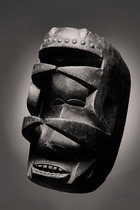Anthropo-zoomorphic face mask "glae" · Côte d'Ivoire, Bété · ID: 3049637
Zemanek-Münster, Würzburg, 10. September 1994, Lot 78
Bernhard Jäger, Frankfurt a. M., Germany
Description
wood, metal, base
Masks “glae” represent the face of an imaginary, fantastic being that combines human features with attributes from the animal world. Particularly striking are warthog tusks, antelope or ram horns, which are superimposed on the face like a “visor”.
Bohumil Holas, who conducted studies in the Bété area in 1968, found that the use of ritual masks was almost completely confined to the western Bété groups around Daloa.
These were in direct and close contact with the Niabwa and thus had the opportunity to draw inspiration from the Wè-Guéré mask types. Indeed, the physiognomy and the appearance of Guéré, Niabwa and Bété masks display undeniable similarities.
According to records of a traveler named Armistead P. Rood, who observed a masked ceremony in Zahia village, some 20 kilometers from Daloa, in 1969, “Bété masks perform many of the functions documented for their Guéré counterparts: cleansing the village of alien forces: officiating at funerals; levying social criticism; presiding over important trials, preparing the men for the hunt, and leading the people to war.
Masks of the Bete were the property of lineages, or lineage branches and they were only allowed to be worn by men. The identity of the wearer was kept strictly secret: his body was completely hidden under a costume and the eye openings in the mask were just large enough for him to orientate himself to some extent; when the wearers of the mask took turns, this was done in a secret, locked room. The reason for this was that the mask “never died”. It was not a person, but rather a supernatural entity which took possession of its wearer. This entity was so formidable and awesome that it never addressed individuals directly. An interpreter repeated and translated the words of the mask. On the day of the event, the human wearer’s personality is erased by the spirit he incarnates. He is entirely subjugated by the mask’s spirit. He himself becomes the spirit.
Among the Bete as among the Wè, a particular mask, often one that was considered to be the oldest of an important lineage clan, had a more sacred character than others, and was called the “great mask”. It conferred prestige and power on the clan that owned it. It is the one from which all the other “glae” are descended”. The “great masks”, or “sacred masks”, were not of a different type than the others, but were clearly recognisable in the splendour and extent of the associated costumes and headgear.
Comparing literature
Schoffel, Serge, "Masques Bete", Brussels 2013, p. 15 ff.
Publications
AHDRC: 0203066









